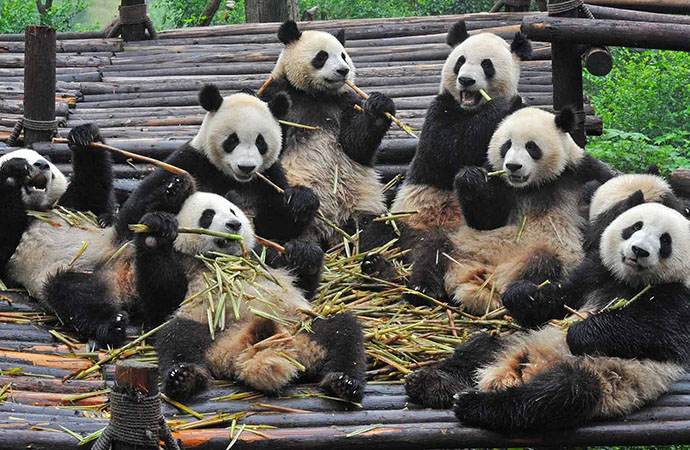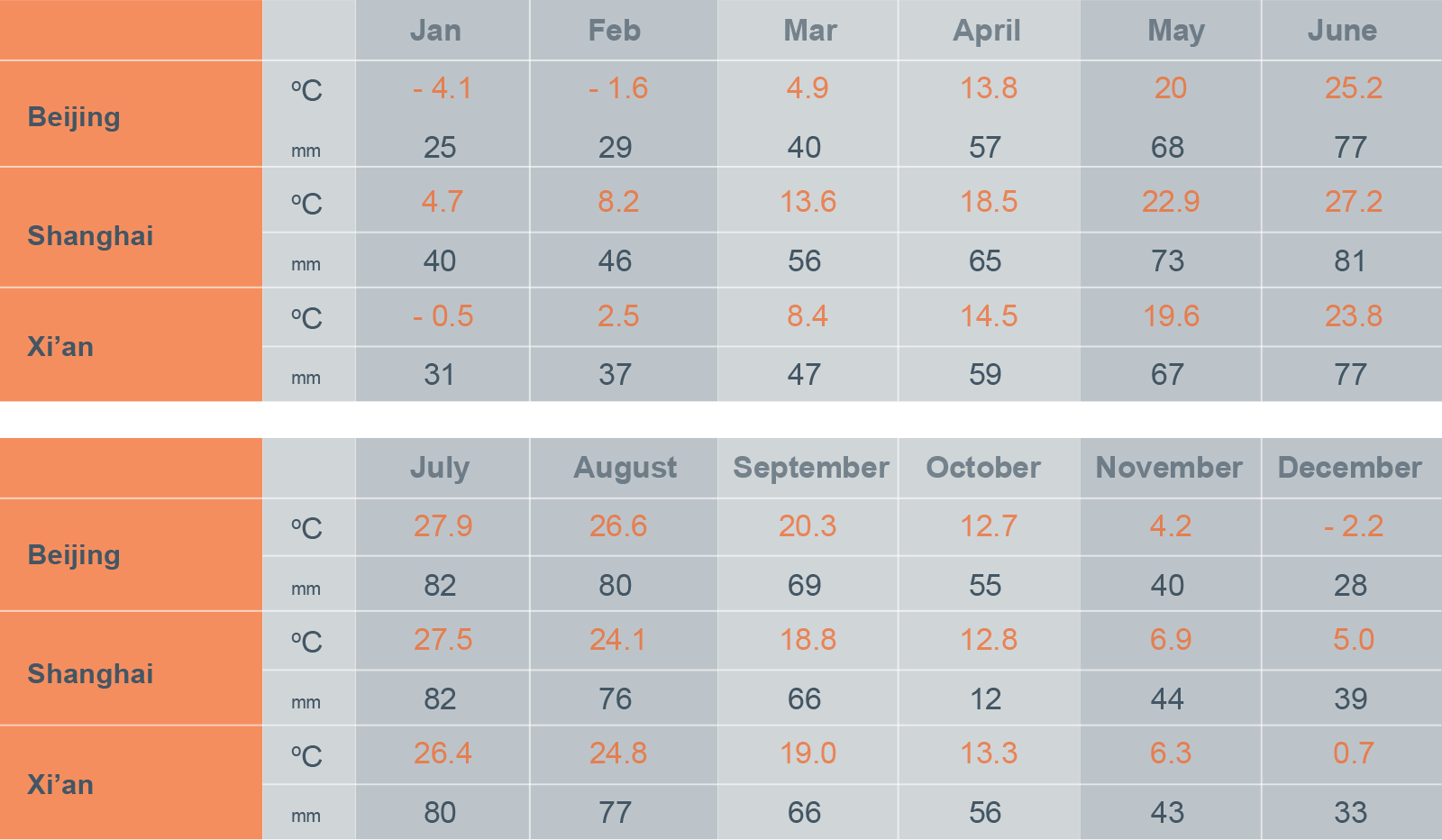
When is the best time to visit China?
When is the best time to visit China?
China at a Glance
Population: 1.4 billion
Capital City: Beijing (approximately 22 million)
Language: Mandarin
Currency: Chinese Yuan Renminbi (CNY)
Time Zone: UTC+8
International Dialing Code: +86
People, Cities & Culture
For over 5000 years, China has maintained its reputation as one of the most innovative and ambitious cultures in the world. Since the days when the Silk Road stretched over multiple deserts and through the highest mountains in Asia, China has been a commercial hub where trade and culture flourished. This massive trade route established cross-continental ties and China as an Empire, and led to China’s rise as one of the world’s most dynamic, powerful and vibrant nations. Today, visitors to China can still witness the might of the ancient Chinese empire with imposing historical landmarks like the Great Wall and the Terracotta Warriors While China is rich in testaments to its ancient culture, this vast nation is also home to some of the largest and most modern cities in the modern world. As more and more people migrate from the countryside to urban areas, China’s largest cities grow at breakneck speed – and with it, the economic strength of modern China. Towering skyscrapers, thriving financial districts and ultra-chic nightlife characterise cities like Beijing and Shanghai – surrounded by immense stretches beautiful landscapes, immense gorges, vast plateaux, majestic holy mountains, rice paddy terraces, towering karsts and multi-coloured lakes.
Beyond historical monuments and vibrant urban centres, China’s varied, vast and ever-evolving culture and heritage is best illustrated in the people’s deeply-held traditional values. The uniquely Chinese philosophy of Confucianism has its roots in nearly every element of Chinese culture and ways of life, and continues to play a role in the worldview of the Chinese people. Even as the country races into the 21st Century, the true heart of China lies in the beliefs, values and traditions that have gone unchanged for centuries.
Transportation
Travelling within China’s major cities is relatively easy, but as many Chinese locals do not speak English, the language barrier is more pronounced here than other parts of Asia. Most large cities have efficient subway systems, which can get you across the city for a low cost. Ticket dispensing kiosks have English settings and are quick and easy to use; stops are announced in both English and Chinese.
Taxis are also a good way to get around, but have your hotel card handy, with the name and address in Chinese as taxi drivers often do not speak English. Taxis are generally the most comfortable and convenient transport option. They are inexpensive, but make sure the meter is on for your journey.
Walking is the best way to get entrenched in local culture, since much of China’s most intriguing communities live within narrow alleyways and neighbourhoods of these bustling cities. To get the best out of these lesser-explored areas, Absolute Asia Tours offers walking tours in Beijing and Shanghai to explore some of these local neighbourhoods. Be sure to watch out for pickpockets, and keep an eye out when crossing traffic.
Weather
China weather
A gargantuan nation bordered by fourteen countries, China’s weather and geography are extremely varied. Yet, being located in the Northern hemisphere, its seasons are timed similarly with Western Europe and North America. The best time to visit China is autumn or spring, when there’s less rainfall and more pleasant temperatures in most regions.
In northern China, home to Beijing and the ancient city of Xi’an, has more extreme variation in temperature. Summers can be as high as 40°C and winters can go down to -15°C. Rain is fairly continuous throughout the year, and sand storms can occur in the middle of April, when strong winds blow from Mongolia into the plain.
Central China, home to Chengdu, is characterised by winters are milder and summers are dryer than further south, making it a more pleasant place to visit year round. A bit further north in Sichuan province, Jiuzhaigou National Park, has similar climate. Due to its high latitude, however, temperatures are generally cooler.
South Western China boasts the karst filled Guilin and has a sub-tropical climate. It is humid year-round, hot in the summer and cool in the winter. Monsoon season lasts from May until September, with increased rainfall.
Eastern China has a sub-tropical climate; summer is rainy and hot, while winter is cold and overcast. Autumn is cool and Spring is warm, making them the most pleasant times to visit cities like Shanghai.
Please note: The weather can be unpredictable in Asia and we suggest you carry an umbrella or raincoat with you no matter which season you choose to travel.
Festivals and National Holidays
Chinese New Year, the most significant holiday of this ancient culture, is a spring festival celebrated from lunar New Years Eve until the Lantern festival on the 15th day of the first lunar month. It usually falls around the end of January or beginning of February. This is an occasion when families come together to clean house, give votive food and paper offerings to ancestors and celebrate by feasting on long noodles for a long life. Red envelopes of lucky money are given to children, while peach blossoms and lots of red decorations and lights adorn buildings. Parades with dancing lions and firecrackers fill the streets of most cities, while many people travel to their hometowns, leaving major cities quieter than usual. Consequently, this a good time to visit temples and major tourist spots, which are less crowded. Transport, however, can be sparse – including even taxis.
It’s also a good time to explore local life in the hutongs, or traditional alleyway neighbourhoods of Beijing, since this time of year promises homes and shops in these areas adorned with decorations and brimming with tasty festival dumplings. At night, cities like Shanghai are alight with red lanterns as well as fireworks, so nightlife still abounds. It is a time when business comes to a halt, so be sure to make all your travel arrangements in advance of this dynamic holiday.
Quingming Festival, or tomb sweeping day, is a popular holiday for ancestral worship celebrated around April 5th. Locals tidy the tombs of their ancestors, make food offerings and light firecrackers as symbols of respect for the deceased. The festival began over 2,500 years ago with the extravagant ceremonies held by emperors to honour ancestors, who sought blessings from them for prosperity and good harvest.
Dragon Boat Festival, celebrated on the 5th day of the 5th lunar month, usually June, is a vibrant festival celebrated in southern China. This is an exciting holiday when dragon boats race across the water, as the teams pull their oars as quick as they can to the thump of a beating drum. Zongzi, a treat of sticky rice wrapped in bamboo or reed leaves stuffed with meat or other fillings, abounds during this holiday, as well as Xionghuang wine is also a popular delicacy; a traditional Chinese medicine drank to ward off evil spirits.
Other important holidays include:
National Day, 1 October
Mid Autumn festival, 15th day of the 8th lunar month
Labour Day, 1 May
Top places to visit in China
Beijing
Not only is Beijing immense, bustling and modern, the current political capital is entrenched in history. Home to the Temple of Heaven, the Forbidden City, the Old Summer Palace, Tiananmen Square and a convenient access point to the Great Wall, the city is a must for any traveller. The maze of hutong alleys also provides a unique glance of pre-modern Chinese life, where many locals live simply and communally. Another cultural icon, Shaolin Kung Fu, can be seen at the Red Theatre for curious voyeurs of this ancient martial art.
Xi’anXi’an
The Silk Road begins in this ancient imperial city, past capital and home to 13 dynasties of the Chinese empire. This walled city is also close to the famous Terracotta Warriors, guarding the anncient tomb of the first Qin Emperor. The food in Xi’an is also well worth a taste, especially in the Muslim quarter. Here, visitors can explore markets and sample distinctive street grub as they walk around, including Xi’an’s iconic lamb stew. This ancient city has history, culture and unique flavours and is well worth the stop on any tours of China.
Chengdu
The “land of milk & honey”, Chengdu is an area known for its abundance of resources, but has topped the to-do lists of travellers thanks to its famous local resident: the giant panda.Chengdu is one of the oldest cities in China with archaeological records dating back over 4,000 years, as well, which makes this a great destination for history buffs. Visitors come for the pandas, but enjoy the pace, flavours and environment of this longstanding city. Locals love to unwind savouring fresh brewed tea and playing mahjong or sharing a spicy Sichuan hot pot.
Shanghai
Shanghai boasts a legacy as an influential trading hub, making its architecture a distinctive fusion of the East and West. It became the most prosperous city in East Asia during the 1920s, and was known as a destination for debauchery and extravagance. Now, resurgence as a major financial capital has led to its rapid development, making it one of the biggest cities in the world. However, the Bund and French Concession are neighbourhoods where visitors can get closer to local lifestyles, while a cruise along the Huangpu River at night shows off the bright sprawling skyline of some of the tallest skyscrapers in the world.
Guilin
Limestone karsts, lakes and rivers abound in the beautiful city of Guilin. Surrounded by majestic landscape, the area is filled with scenic views, one of which is even featured on the ¥ 20 bill. The charming neighbouring town of Yangshuo is a perfect place to board a cruise along the Li River to take in the magnificent sight of the countryside studded with karsts. Nearby, Longshen features centuries-old layers of rice terraces carved along the mountainside, and its summit is referred to as the “Dragon’s Backbone”.
Top things to do in China
Walk the Great Wall
Hike up the ancient steps along the most iconic structure in the world. The Great Wall spans over 6,000 kilometres and demonstrates the incredible engineering and military might of this ancient Empire. The wall is actually a series of walls interconnected, and the Mutianyu section is just north of Beijing. Walk along the wall’s high ridges and explore its ancient watchtowers, dating back more than 2,000 years. Savour superb views of the countryside, and consider gliding down on a toboggan or seeing more by cable car.
See the Giant Pandas
A mere 50 years ago, there was little belief that breeding pandas and protecting the species from extinction would be possible. However, the Panda Research Centre in Chengdu has done just that. Located in a region where pandas can still be found in the wild, the centre has established a pristine facility for this cuddly creature. Now the number one destination for visitors, you can observe China’s laid back wildlife local lounging and chewing on bamboo in its natural habitat.
Taste the Peking Duck of Beijing
Beijing is a busy and modern city, but after a quick walk down a hutong alleyway, the best way to taste the true flavour of the city is with the city’s most famous dish: Peking Duck. Blanched, marinated with molasses and slow roasted over a fire for hours, the duck’s crispy brown skin is a signature taste of Beijing. It is cooked in the same style as during the late Quin dynasty, and is eaten with hoisin sauce, green onions and small crepes. Dig in!
See the Terracotta Warriors
A mere 35 kilometres north east of Xi’an, a local farmer in 1974 discovered this formidable mausoleum of the mighty Emperor Qin. It houses thousands of statues of warriors and cavalry made out of terracotta, his army for the afterlife. These life sized figures each have different facial expressions and characteristics – and their detail and craftsmanship are considered one of the most stunning examples to the might of the ancient Chinese empire. Be sure to visit this unique, 2,000 year-old archaeological find, a must see for any traveller.
Shop in Shanghai
A global financial centre, Shanghai has some of the best shopping in the world, both high-end brands, cheap deals and everything in-between. Start off at the pedestrian filled Nanjing Road, the best place in China to stock up on luxury brands. In Xiangyang market, stumble across dozens of flea markets underneath mega shopping malls. Between bouts of retail therapy, head to Yuyuan Garden for a dose of peaceful rejuvenation – that is, before browsing the artisanal items and souvenirs for sale at its outdoor bazaar.
Walk the Bund in Shanghai
At the turn of the century, the Bund was the prominent financial centre of East Asia. Historic buildings with French, English and Chinese architectural elements dot this pedestrian walkway. Stroll along the Bund and take in the views of Shanghai’s distinctive past. Just across the Huangpu River, the Bund is also a perfect place to see the towering ultra-modern skyscrapers dotting the horizon.
Walk along the majestic waters of Jiuzhaigou
Aside from incredible history and dynamic urban culture, China is also home to Jiuzhaigou, or the “Nine Village Valley,” on the edge of the Tibetan Plateau. This scenic destination is tucked away in the north of Sichuan province, and features a gorgeous nature reserve rich with cascading waterfalls, snow-capped mountain peaks and multi-coloured lakes. Previously one of China’s best-kept secrets, this vibrant national park welcomes more and more visitors each year – so it’s worth exploring while it still retains its off the beaten track charm.
Hike up Mount E’mei
Mount E’mei is one of the Four Sacred Buddhist Mountains of China, located in Sichuan province. Hike up or ride a cable car to Wannian, a Buddhist temple midway up to the mountain to reach the highest peak, known as the Golden Summit, over 3,000 meters above sea level. Take in spectacular views, where you might witness the rare sea of clouds that occassionally engulfs the summit. From the Golden Summit it’s an easy stroll down to the natural monkey reserve, abundant with Tibetan Macaques. These curious creatures have a penchant for snatching your personal items when you aren’t looking.
Travel Guide By City
TAILOR-MADE HOLIDAY
Plan your adventure tour with our travel experts help plan. Speak with a Travel expert via WHATSAPP: +84988600388 or Email at info@flipsideadventuretravel.com


 In-Depth Knowledge with Local Insight
In-Depth Knowledge with Local Insight 


